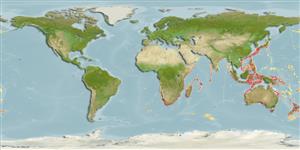Common names from other countries
Environment: milieu / climate zone / depth range / distribution range
Ökologie
seewasser bathydemersal; tiefenbereich 90 - 435 m (Ref. 33352). Deep-water
Indo-West Pacific: South Africa to northwestern Australia; northward to South China Sea (Ref. 33352). Southeast Atlantic: southeast coast of South Africa (Ref. 4919). Mediterranean (Lessepsian migrant) (Ref. 96612).
Size / Gewicht / Alter
Maturity: Lm ? range ? - ? cm
Max length : 12.0 cm TL Männchen/unbestimmt; (Ref. 4919)
Rückenflossenstacheln (insgesamt) : 0; Rückenflossenweichstrahlen (insgesamt) : 8 - 9; Afterflossenstacheln: 0; Afterflossenweichstrahlen: 6 - 7. Grey with a dark blotch above and behind eye and at base of dorsal fin; rear margin of caudal fin black; black specks on belly (Ref. 4919).
Minimum depth reported taken from Ref. 127989.
Life cycle and mating behavior
Maturities | Fortpflanzung | Spawnings | Egg(s) | Fecundities | Larven
Leis, J.M., 1986. Diodontidae. p. 903-907. In M.M. Smith and P.C. Heemstra (eds.) Smiths' sea fishes. Springer-Verlag, Berlin. (Ref. 4423)
IUCN Rote Liste Status (Ref. 130435)
CITES (Ref. 128078)
Not Evaluated
Bedrohung für Menschen
Harmless
Nutzung durch Menschen
Tools
Zusatzinformationen
Download XML
Internet Quellen
Estimates based on models
Preferred temperature (Ref.
115969): 9 - 16.8, mean 12 (based on 156 cells).
Phylogenetic diversity index (Ref.
82804): PD
50 = 1.0000 [Uniqueness, from 0.5 = low to 2.0 = high].
Bayesian length-weight: a=0.02570 (0.01193 - 0.05536), b=2.88 (2.71 - 3.05), in cm Total Length, based on LWR estimates for this (Sub)family-body shape (Ref.
93245).
Trophic level (Ref.
69278): 3.3 ±0.2 se; based on size and trophs of closest relatives
Widerstandsfähigkeit (Ref.
120179): hoch, Verdopplung der Population dauert weniger als 15 Monate. (Preliminary K or Fecundity.).
Fishing Vulnerability (Ref.
59153): Low vulnerability (10 of 100).
